Alpha mapping in DirectX 11 is the process of using the alpha layer of a texture to determine the blending amount for each pixel when combining two textures.
To start the process, you first create an alpha layer for a texture such as follows:
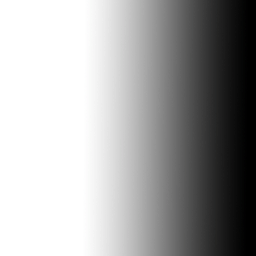
Each pixel is just a 0.0 to 1.0 float range indicating how to combine two textures.
For example, if the alpha value at a certain pixel is 0.3 you would take 30% of the base texture pixel value and combine it with 70% of the color texture pixel.
In this tutorial we will combine the following two textures based on the alpha map:
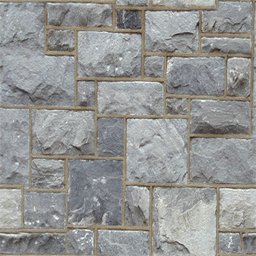
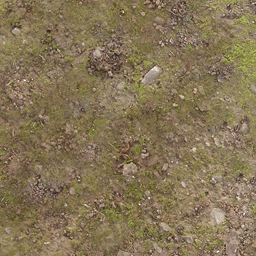
The final result will be the following:
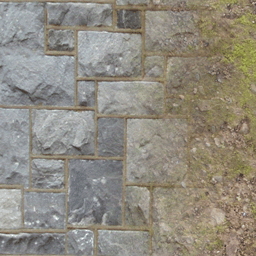
In this tutorial I will be separating the alpha map onto its own individual texture.
This gives us the ability to create several alpha maps and then combine the same two color and base textures in many different ways.
The code in this tutorial is based on the previous tutorial.
Framework
The framework has been updated to replace LightMapShaderClass with the new AlphaMapShaderClass.
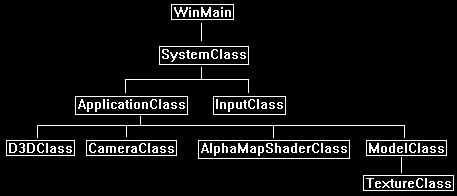
Alphamap.vs
The alpha map vertex shader is just the light map shader renamed from the previous tutorial.
////////////////////////////////////////////////////////////////////////////////
// Filename: alphamap.vs
////////////////////////////////////////////////////////////////////////////////
/////////////
// GLOBALS //
/////////////
cbuffer MatrixBuffer
{
matrix worldMatrix;
matrix viewMatrix;
matrix projectionMatrix;
};
//////////////
// TYPEDEFS //
//////////////
struct VertexInputType
{
float4 position : POSITION;
float2 tex : TEXCOORD0;
float3 normal : NORMAL;
};
struct PixelInputType
{
float4 position : SV_POSITION;
float2 tex : TEXCOORD0;
};
////////////////////////////////////////////////////////////////////////////////
// Vertex Shader
////////////////////////////////////////////////////////////////////////////////
PixelInputType AlphaMapVertexShader(VertexInputType input)
{
PixelInputType output;
// Change the position vector to be 4 units for proper matrix calculations.
input.position.w = 1.0f;
// Calculate the position of the vertex against the world, view, and projection matrices.
output.position = mul(input.position, worldMatrix);
output.position = mul(output.position, viewMatrix);
output.position = mul(output.position, projectionMatrix);
// Store the texture coordinates for the pixel shader.
output.tex = input.tex;
return output;
}
Alphamap.ps
////////////////////////////////////////////////////////////////////////////////
// Filename: alphamap.ps
////////////////////////////////////////////////////////////////////////////////
/////////////
// GLOBALS //
/////////////
Texture2D shaderTexture1 : register(t0);
Texture2D shaderTexture2 : register(t1);
The first change to the pixel shader is the addition of a third texture for holding the alpha map.
Texture2D shaderTexture3 : register(t2);
SamplerState SampleType : register(s0);
//////////////
// TYPEDEFS //
//////////////
struct PixelInputType
{
float4 position : SV_POSITION;
float2 tex : TEXCOORD0;
};
In the alpha map pixel shader, we first take a sample of the pixel from the two color textures and alpha texture.
Then we multiply the alpha value by the base color to get the pixel value for the base texture.
After that we multiply the inverse of the alpha (1.0 - alpha) by the second color texture to get the pixel value for the second texture.
We then add the two pixel values together and saturate to produce the final blended pixel.
////////////////////////////////////////////////////////////////////////////////
// Pixel Shader
////////////////////////////////////////////////////////////////////////////////
float4 AlphaMapPixelShader(PixelInputType input) : SV_TARGET
{
float4 color1;
float4 color2;
float4 alphaValue;
float4 blendColor;
// Get the pixel color from the first texture.
color1 = shaderTexture1.Sample(SampleType, input.tex);
// Get the pixel color from the second texture.
color2 = shaderTexture2.Sample(SampleType, input.tex);
// Get the pixel color from the alpha texture.
alphaValue = shaderTexture3.Sample(SampleType, input.tex);
// Combine the two textures based on the alpha value.
blendColor = (alphaValue * color1) + ((1.0 - alphaValue) * color2);
// Saturate the final color value.
blendColor = saturate(blendColor);
return blendColor;
}
Alphamapshaderclass.h
The AlphaMapShaderClass is the LightMapShaderClass slightly modified from the previous tutorial.
////////////////////////////////////////////////////////////////////////////////
// Filename: alphamapshaderclass.h
////////////////////////////////////////////////////////////////////////////////
#ifndef _ALPHAMAPSHADERCLASS_H_
#define _ALPHAMAPSHADERCLASS_H_
//////////////
// INCLUDES //
//////////////
#include <d3d11.h>
#include <d3dcompiler.h>
#include <directxmath.h>
#include <fstream>
using namespace DirectX;
using namespace std;
////////////////////////////////////////////////////////////////////////////////
// Class name: AlphaMapShaderClass
////////////////////////////////////////////////////////////////////////////////
class AlphaMapShaderClass
{
private:
struct MatrixBufferType
{
XMMATRIX world;
XMMATRIX view;
XMMATRIX projection;
};
public:
AlphaMapShaderClass();
AlphaMapShaderClass(const AlphaMapShaderClass&);
~AlphaMapShaderClass();
bool Initialize(ID3D11Device*, HWND);
void Shutdown();
bool Render(ID3D11DeviceContext*, int, XMMATRIX, XMMATRIX, XMMATRIX, ID3D11ShaderResourceView*, ID3D11ShaderResourceView*, ID3D11ShaderResourceView*);
private:
bool InitializeShader(ID3D11Device*, HWND, WCHAR*, WCHAR*);
void ShutdownShader();
void OutputShaderErrorMessage(ID3D10Blob*, HWND, WCHAR*);
bool SetShaderParameters(ID3D11DeviceContext*, XMMATRIX, XMMATRIX, XMMATRIX, ID3D11ShaderResourceView*, ID3D11ShaderResourceView*, ID3D11ShaderResourceView*);
void RenderShader(ID3D11DeviceContext*, int);
private:
ID3D11VertexShader* m_vertexShader;
ID3D11PixelShader* m_pixelShader;
ID3D11InputLayout* m_layout;
ID3D11Buffer* m_matrixBuffer;
ID3D11SamplerState* m_sampleState;
};
#endif
Alphamapshaderclass.cpp
////////////////////////////////////////////////////////////////////////////////
// Filename: alphamapshaderclass.cpp
////////////////////////////////////////////////////////////////////////////////
#include "alphamapshaderclass.h"
AlphaMapShaderClass::AlphaMapShaderClass()
{
m_vertexShader = 0;
m_pixelShader = 0;
m_layout = 0;
m_matrixBuffer = 0;
m_sampleState = 0;
}
AlphaMapShaderClass::AlphaMapShaderClass(const AlphaMapShaderClass& other)
{
}
AlphaMapShaderClass::~AlphaMapShaderClass()
{
}
bool AlphaMapShaderClass::Initialize(ID3D11Device* device, HWND hwnd)
{
bool result;
wchar_t vsFilename[128];
wchar_t psFilename[128];
int error;
The first change is that the alphamap.vs and alphamap.ps HLSL shader files are now loaded.
// Set the filename of the vertex shader.
error = wcscpy_s(vsFilename, 128, L"../Engine/alphamap.vs");
if(error != 0)
{
return false;
}
// Set the filename of the pixel shader.
error = wcscpy_s(psFilename, 128, L"../Engine/alphamap.ps");
if(error != 0)
{
return false;
}
// Initialize the vertex and pixel shaders.
result = InitializeShader(device, hwnd, vsFilename, psFilename);
if(!result)
{
return false;
}
return true;
}
void AlphaMapShaderClass::Shutdown()
{
// Shutdown the vertex and pixel shaders as well as the related objects.
ShutdownShader();
return;
}
bool AlphaMapShaderClass::Render(ID3D11DeviceContext* deviceContext, int indexCount, XMMATRIX worldMatrix, XMMATRIX viewMatrix, XMMATRIX projectionMatrix,
ID3D11ShaderResourceView* texture1, ID3D11ShaderResourceView* texture2, ID3D11ShaderResourceView* texture3)
{
bool result;
// Set the shader parameters that it will use for rendering.
result = SetShaderParameters(deviceContext, worldMatrix, viewMatrix, projectionMatrix, texture1, texture2, texture3);
if(!result)
{
return false;
}
// Now render the prepared buffers with the shader.
RenderShader(deviceContext, indexCount);
return true;
}
bool AlphaMapShaderClass::InitializeShader(ID3D11Device* device, HWND hwnd, WCHAR* vsFilename, WCHAR* psFilename)
{
HRESULT result;
ID3D10Blob* errorMessage;
ID3D10Blob* vertexShaderBuffer;
ID3D10Blob* pixelShaderBuffer;
D3D11_INPUT_ELEMENT_DESC polygonLayout[3];
unsigned int numElements;
D3D11_BUFFER_DESC matrixBufferDesc;
D3D11_SAMPLER_DESC samplerDesc;
// Initialize the pointers this function will use to null.
errorMessage = 0;
vertexShaderBuffer = 0;
pixelShaderBuffer = 0;
The alpha map vertex shader is loaded here.
// Compile the vertex shader code.
result = D3DCompileFromFile(vsFilename, NULL, NULL, "AlphaMapVertexShader", "vs_5_0", D3D10_SHADER_ENABLE_STRICTNESS, 0,
&vertexShaderBuffer, &errorMessage);
if(FAILED(result))
{
// If the shader failed to compile it should have writen something to the error message.
if(errorMessage)
{
OutputShaderErrorMessage(errorMessage, hwnd, vsFilename);
}
// If there was nothing in the error message then it simply could not find the shader file itself.
else
{
MessageBox(hwnd, vsFilename, L"Missing Shader File", MB_OK);
}
return false;
}
The alpha map pixel shader is loaded here.
// Compile the pixel shader code.
result = D3DCompileFromFile(psFilename, NULL, NULL, "AlphaMapPixelShader", "ps_5_0", D3D10_SHADER_ENABLE_STRICTNESS, 0,
&pixelShaderBuffer, &errorMessage);
if(FAILED(result))
{
// If the shader failed to compile it should have writen something to the error message.
if(errorMessage)
{
OutputShaderErrorMessage(errorMessage, hwnd, psFilename);
}
// If there was nothing in the error message then it simply could not find the file itself.
else
{
MessageBox(hwnd, psFilename, L"Missing Shader File", MB_OK);
}
return false;
}
// Create the vertex shader from the buffer.
result = device->CreateVertexShader(vertexShaderBuffer->GetBufferPointer(), vertexShaderBuffer->GetBufferSize(), NULL, &m_vertexShader);
if(FAILED(result))
{
return false;
}
// Create the pixel shader from the buffer.
result = device->CreatePixelShader(pixelShaderBuffer->GetBufferPointer(), pixelShaderBuffer->GetBufferSize(), NULL, &m_pixelShader);
if(FAILED(result))
{
return false;
}
// Create the vertex input layout description.
polygonLayout[0].SemanticName = "POSITION";
polygonLayout[0].SemanticIndex = 0;
polygonLayout[0].Format = DXGI_FORMAT_R32G32B32_FLOAT;
polygonLayout[0].InputSlot = 0;
polygonLayout[0].AlignedByteOffset = 0;
polygonLayout[0].InputSlotClass = D3D11_INPUT_PER_VERTEX_DATA;
polygonLayout[0].InstanceDataStepRate = 0;
polygonLayout[1].SemanticName = "TEXCOORD";
polygonLayout[1].SemanticIndex = 0;
polygonLayout[1].Format = DXGI_FORMAT_R32G32_FLOAT;
polygonLayout[1].InputSlot = 0;
polygonLayout[1].AlignedByteOffset = D3D11_APPEND_ALIGNED_ELEMENT;
polygonLayout[1].InputSlotClass = D3D11_INPUT_PER_VERTEX_DATA;
polygonLayout[1].InstanceDataStepRate = 0;
polygonLayout[2].SemanticName = "NORMAL";
polygonLayout[2].SemanticIndex = 0;
polygonLayout[2].Format = DXGI_FORMAT_R32G32B32_FLOAT;
polygonLayout[2].InputSlot = 0;
polygonLayout[2].AlignedByteOffset = D3D11_APPEND_ALIGNED_ELEMENT;
polygonLayout[2].InputSlotClass = D3D11_INPUT_PER_VERTEX_DATA;
polygonLayout[2].InstanceDataStepRate = 0;
// Get a count of the elements in the layout.
numElements = sizeof(polygonLayout) / sizeof(polygonLayout[0]);
// Create the vertex input layout.
result = device->CreateInputLayout(polygonLayout, numElements, vertexShaderBuffer->GetBufferPointer(),
vertexShaderBuffer->GetBufferSize(), &m_layout);
if(FAILED(result))
{
return false;
}
// Release the vertex shader buffer and pixel shader buffer since they are no longer needed.
vertexShaderBuffer->Release();
vertexShaderBuffer = 0;
pixelShaderBuffer->Release();
pixelShaderBuffer = 0;
// Setup the description of the dynamic matrix constant buffer that is in the vertex shader.
matrixBufferDesc.Usage = D3D11_USAGE_DYNAMIC;
matrixBufferDesc.ByteWidth = sizeof(MatrixBufferType);
matrixBufferDesc.BindFlags = D3D11_BIND_CONSTANT_BUFFER;
matrixBufferDesc.CPUAccessFlags = D3D11_CPU_ACCESS_WRITE;
matrixBufferDesc.MiscFlags = 0;
matrixBufferDesc.StructureByteStride = 0;
// Create the constant buffer pointer so we can access the vertex shader constant buffer from within this class.
result = device->CreateBuffer(&matrixBufferDesc, NULL, &m_matrixBuffer);
if(FAILED(result))
{
return false;
}
// Create a texture sampler state description.
samplerDesc.Filter = D3D11_FILTER_MIN_MAG_MIP_LINEAR;
samplerDesc.AddressU = D3D11_TEXTURE_ADDRESS_WRAP;
samplerDesc.AddressV = D3D11_TEXTURE_ADDRESS_WRAP;
samplerDesc.AddressW = D3D11_TEXTURE_ADDRESS_WRAP;
samplerDesc.MipLODBias = 0.0f;
samplerDesc.MaxAnisotropy = 1;
samplerDesc.ComparisonFunc = D3D11_COMPARISON_ALWAYS;
samplerDesc.BorderColor[0] = 0;
samplerDesc.BorderColor[1] = 0;
samplerDesc.BorderColor[2] = 0;
samplerDesc.BorderColor[3] = 0;
samplerDesc.MinLOD = 0;
samplerDesc.MaxLOD = D3D11_FLOAT32_MAX;
// Create the texture sampler state.
result = device->CreateSamplerState(&samplerDesc, &m_sampleState);
if(FAILED(result))
{
return false;
}
return true;
}
void AlphaMapShaderClass::ShutdownShader()
{
// Release the sampler state.
if(m_sampleState)
{
m_sampleState->Release();
m_sampleState = 0;
}
// Release the matrix constant buffer.
if(m_matrixBuffer)
{
m_matrixBuffer->Release();
m_matrixBuffer = 0;
}
// Release the layout.
if(m_layout)
{
m_layout->Release();
m_layout = 0;
}
// Release the pixel shader.
if(m_pixelShader)
{
m_pixelShader->Release();
m_pixelShader = 0;
}
// Release the vertex shader.
if(m_vertexShader)
{
m_vertexShader->Release();
m_vertexShader = 0;
}
return;
}
void AlphaMapShaderClass::OutputShaderErrorMessage(ID3D10Blob* errorMessage, HWND hwnd, WCHAR* shaderFilename)
{
char* compileErrors;
unsigned long long bufferSize, i;
ofstream fout;
// Get a pointer to the error message text buffer.
compileErrors = (char*)(errorMessage->GetBufferPointer());
// Get the length of the message.
bufferSize = errorMessage->GetBufferSize();
// Open a file to write the error message to.
fout.open("shader-error.txt");
// Write out the error message.
for(i=0; i<bufferSize; i++)
{
fout << compileErrors[i];
}
// Close the file.
fout.close();
// Release the error message.
errorMessage->Release();
errorMessage = 0;
// Pop a message up on the screen to notify the user to check the text file for compile errors.
MessageBox(hwnd, L"Error compiling shader. Check shader-error.txt for message.", shaderFilename, MB_OK);
return;
}
bool AlphaMapShaderClass::SetShaderParameters(ID3D11DeviceContext* deviceContext, XMMATRIX worldMatrix, XMMATRIX viewMatrix, XMMATRIX projectionMatrix,
ID3D11ShaderResourceView* texture1, ID3D11ShaderResourceView* texture2, ID3D11ShaderResourceView* texture3)
{
HRESULT result;
D3D11_MAPPED_SUBRESOURCE mappedResource;
MatrixBufferType* dataPtr;
unsigned int bufferNumber;
// Transpose the matrices to prepare them for the shader.
worldMatrix = XMMatrixTranspose(worldMatrix);
viewMatrix = XMMatrixTranspose(viewMatrix);
projectionMatrix = XMMatrixTranspose(projectionMatrix);
// Lock the constant buffer so it can be written to.
result = deviceContext->Map(m_matrixBuffer, 0, D3D11_MAP_WRITE_DISCARD, 0, &mappedResource);
if(FAILED(result))
{
return false;
}
// Get a pointer to the data in the constant buffer.
dataPtr = (MatrixBufferType*)mappedResource.pData;
// Copy the matrices into the constant buffer.
dataPtr->world = worldMatrix;
dataPtr->view = viewMatrix;
dataPtr->projection = projectionMatrix;
// Unlock the constant buffer.
deviceContext->Unmap(m_matrixBuffer, 0);
// Set the position of the constant buffer in the vertex shader.
bufferNumber = 0;
// Finally set the constant buffer in the vertex shader with the updated values.
deviceContext->VSSetConstantBuffers(bufferNumber, 1, &m_matrixBuffer);
In the SetShaderParameters function we now setup a third texture.
This third texture will be the alpha texture since the first two textures are the two color textures.
// Set shader texture resources in the pixel shader.
deviceContext->PSSetShaderResources(0, 1, &texture1);
deviceContext->PSSetShaderResources(1, 1, &texture2);
deviceContext->PSSetShaderResources(2, 1, &texture3);
return true;
}
void AlphaMapShaderClass::RenderShader(ID3D11DeviceContext* deviceContext, int indexCount)
{
// Set the vertex input layout.
deviceContext->IASetInputLayout(m_layout);
// Set the vertex and pixel shaders that will be used to render this triangle.
deviceContext->VSSetShader(m_vertexShader, NULL, 0);
deviceContext->PSSetShader(m_pixelShader, NULL, 0);
// Set the sampler state in the pixel shader.
deviceContext->PSSetSamplers(0, 1, &m_sampleState);
// Render the triangle.
deviceContext->DrawIndexed(indexCount, 0, 0);
return;
}
Modelclass.h
The ModelClass has been modified to use a third texture now.
////////////////////////////////////////////////////////////////////////////////
// Filename: modelclass.h
////////////////////////////////////////////////////////////////////////////////
#ifndef _MODELCLASS_H_
#define _MODELCLASS_H_
//////////////
// INCLUDES //
//////////////
#include <d3d11.h>
#include <directxmath.h>
#include <fstream>
using namespace DirectX;
using namespace std;
///////////////////////
// MY CLASS INCLUDES //
///////////////////////
#include "textureclass.h"
////////////////////////////////////////////////////////////////////////////////
// Class name: ModelClass
////////////////////////////////////////////////////////////////////////////////
class ModelClass
{
private:
struct VertexType
{
XMFLOAT3 position;
XMFLOAT2 texture;
XMFLOAT3 normal;
};
struct ModelType
{
float x, y, z;
float tu, tv;
float nx, ny, nz;
};
public:
ModelClass();
ModelClass(const ModelClass&);
~ModelClass();
bool Initialize(ID3D11Device*, ID3D11DeviceContext*, char*, char*, char*, char*);
void Shutdown();
void Render(ID3D11DeviceContext*);
int GetIndexCount();
ID3D11ShaderResourceView* GetTexture(int);
private:
bool InitializeBuffers(ID3D11Device*);
void ShutdownBuffers();
void RenderBuffers(ID3D11DeviceContext*);
bool LoadTextures(ID3D11Device*, ID3D11DeviceContext*, char*, char*, char*);
void ReleaseTextures();
bool LoadModel(char*);
void ReleaseModel();
private:
ID3D11Buffer *m_vertexBuffer, *m_indexBuffer;
int m_vertexCount, m_indexCount;
TextureClass* m_Textures;
ModelType* m_model;
};
#endif
Modelclass.cpp
////////////////////////////////////////////////////////////////////////////////
// Filename: modelclass.cpp
////////////////////////////////////////////////////////////////////////////////
#include "modelclass.h"
ModelClass::ModelClass()
{
m_vertexBuffer = 0;
m_indexBuffer = 0;
m_Textures = 0;
m_model = 0;
}
ModelClass::ModelClass(const ModelClass& other)
{
}
ModelClass::~ModelClass()
{
}
bool ModelClass::Initialize(ID3D11Device* device, ID3D11DeviceContext* deviceContext, char* modelFilename, char* textureFilename1, char* textureFilename2,
char* textureFilename3)
{
bool result;
// Load in the model data.
result = LoadModel(modelFilename);
if(!result)
{
return false;
}
// Initialize the vertex and index buffers.
result = InitializeBuffers(device);
if(!result)
{
return false;
}
// Load the textures for this model.
result = LoadTextures(device, deviceContext, textureFilename1, textureFilename2, textureFilename3);
if(!result)
{
return false;
}
return true;
}
void ModelClass::Shutdown()
{
// Release the model textures.
ReleaseTextures();
// Shutdown the vertex and index buffers.
ShutdownBuffers();
// Release the model data.
ReleaseModel();
return;
}
void ModelClass::Render(ID3D11DeviceContext* deviceContext)
{
// Put the vertex and index buffers on the graphics pipeline to prepare them for drawing.
RenderBuffers(deviceContext);
return;
}
int ModelClass::GetIndexCount()
{
return m_indexCount;
}
ID3D11ShaderResourceView* ModelClass::GetTexture(int index)
{
return m_Textures[index].GetTexture();
}
bool ModelClass::InitializeBuffers(ID3D11Device* device)
{
VertexType* vertices;
unsigned long* indices;
D3D11_BUFFER_DESC vertexBufferDesc, indexBufferDesc;
D3D11_SUBRESOURCE_DATA vertexData, indexData;
HRESULT result;
int i;
// Create the vertex array.
vertices = new VertexType[m_vertexCount];
// Create the index array.
indices = new unsigned long[m_indexCount];
// Load the vertex array and index array with data.
for(i=0; i<m_vertexCount; i++)
{
vertices[i].position = XMFLOAT3(m_model[i].x, m_model[i].y, m_model[i].z);
vertices[i].texture = XMFLOAT2(m_model[i].tu, m_model[i].tv);
vertices[i].normal = XMFLOAT3(m_model[i].nx, m_model[i].ny, m_model[i].nz);
indices[i] = i;
}
// Set up the description of the static vertex buffer.
vertexBufferDesc.Usage = D3D11_USAGE_DEFAULT;
vertexBufferDesc.ByteWidth = sizeof(VertexType) * m_vertexCount;
vertexBufferDesc.BindFlags = D3D11_BIND_VERTEX_BUFFER;
vertexBufferDesc.CPUAccessFlags = 0;
vertexBufferDesc.MiscFlags = 0;
vertexBufferDesc.StructureByteStride = 0;
// Give the subresource structure a pointer to the vertex data.
vertexData.pSysMem = vertices;
vertexData.SysMemPitch = 0;
vertexData.SysMemSlicePitch = 0;
// Now create the vertex buffer.
result = device->CreateBuffer(&vertexBufferDesc, &vertexData, &m_vertexBuffer);
if(FAILED(result))
{
return false;
}
// Set up the description of the static index buffer.
indexBufferDesc.Usage = D3D11_USAGE_DEFAULT;
indexBufferDesc.ByteWidth = sizeof(unsigned long) * m_indexCount;
indexBufferDesc.BindFlags = D3D11_BIND_INDEX_BUFFER;
indexBufferDesc.CPUAccessFlags = 0;
indexBufferDesc.MiscFlags = 0;
indexBufferDesc.StructureByteStride = 0;
// Give the subresource structure a pointer to the index data.
indexData.pSysMem = indices;
indexData.SysMemPitch = 0;
indexData.SysMemSlicePitch = 0;
// Create the index buffer.
result = device->CreateBuffer(&indexBufferDesc, &indexData, &m_indexBuffer);
if(FAILED(result))
{
return false;
}
// Release the arrays now that the vertex and index buffers have been created and loaded.
delete [] vertices;
vertices = 0;
delete [] indices;
indices = 0;
return true;
}
void ModelClass::ShutdownBuffers()
{
// Release the index buffer.
if(m_indexBuffer)
{
m_indexBuffer->Release();
m_indexBuffer = 0;
}
// Release the vertex buffer.
if(m_vertexBuffer)
{
m_vertexBuffer->Release();
m_vertexBuffer = 0;
}
return;
}
void ModelClass::RenderBuffers(ID3D11DeviceContext* deviceContext)
{
unsigned int stride;
unsigned int offset;
// Set vertex buffer stride and offset.
stride = sizeof(VertexType);
offset = 0;
// Set the vertex buffer to active in the input assembler so it can be rendered.
deviceContext->IASetVertexBuffers(0, 1, &m_vertexBuffer, &stride, &offset);
// Set the index buffer to active in the input assembler so it can be rendered.
deviceContext->IASetIndexBuffer(m_indexBuffer, DXGI_FORMAT_R32_UINT, 0);
// Set the type of primitive that should be rendered from this vertex buffer, in this case triangles.
deviceContext->IASetPrimitiveTopology(D3D11_PRIMITIVE_TOPOLOGY_TRIANGLELIST);
return;
}
bool ModelClass::LoadTextures(ID3D11Device* device, ID3D11DeviceContext* deviceContext, char* filename1, char* filename2, char* filename3)
{
bool result;
// Create and initialize the texture object array.
m_Textures = new TextureClass[3];
result = m_Textures[0].Initialize(device, deviceContext, filename1);
if(!result)
{
return false;
}
result = m_Textures[1].Initialize(device, deviceContext, filename2);
if(!result)
{
return false;
}
result = m_Textures[2].Initialize(device, deviceContext, filename3);
if(!result)
{
return false;
}
return true;
}
void ModelClass::ReleaseTextures()
{
// Release the texture object array.
if(m_Textures)
{
m_Textures[0].Shutdown();
m_Textures[1].Shutdown();
m_Textures[2].Shutdown();
delete [] m_Textures;
m_Textures = 0;
}
return;
}
bool ModelClass::LoadModel(char* filename)
{
ifstream fin;
char input;
int i;
// Open the model file.
fin.open(filename);
// If it could not open the file then exit.
if(fin.fail())
{
return false;
}
// Read up to the value of vertex count.
fin.get(input);
while (input != ':')
{
fin.get(input);
}
// Read in the vertex count.
fin >> m_vertexCount;
// Set the number of indices to be the same as the vertex count.
m_indexCount = m_vertexCount;
// Create the model using the vertex count that was read in.
m_model = new ModelType[m_vertexCount];
// Read up to the beginning of the data.
fin.get(input);
while (input != ':')
{
fin.get(input);
}
fin.get(input);
fin.get(input);
// Read in the vertex data.
for(i=0; i<m_vertexCount; i++)
{
fin >> m_model[i].x >> m_model[i].y >> m_model[i].z;
fin >> m_model[i].tu >> m_model[i].tv;
fin >> m_model[i].nx >> m_model[i].ny >> m_model[i].nz;
}
// Close the model file.
fin.close();
return true;
}
void ModelClass::ReleaseModel()
{
if(m_model)
{
delete [] m_model;
m_model = 0;
}
return;
}
Applicationclass.h
We have added the new AlphaMapShaderClass to the ApplicationClass.
////////////////////////////////////////////////////////////////////////////////
// Filename: applicationclass.h
////////////////////////////////////////////////////////////////////////////////
#ifndef _APPLICATIONCLASS_H_
#define _APPLICATIONCLASS_H_
///////////////////////
// MY CLASS INCLUDES //
///////////////////////
#include "d3dclass.h"
#include "inputclass.h"
#include "cameraclass.h"
#include "alphamapshaderclass.h"
#include "modelclass.h"
/////////////
// GLOBALS //
/////////////
const bool FULL_SCREEN = false;
const bool VSYNC_ENABLED = true;
const float SCREEN_DEPTH = 1000.0f;
const float SCREEN_NEAR = 0.3f;
////////////////////////////////////////////////////////////////////////////////
// Class name: ApplicationClass
////////////////////////////////////////////////////////////////////////////////
class ApplicationClass
{
public:
ApplicationClass();
ApplicationClass(const ApplicationClass&);
~ApplicationClass();
bool Initialize(int, int, HWND);
void Shutdown();
bool Frame(InputClass*);
private:
bool Render();
private:
D3DClass* m_Direct3D;
CameraClass* m_Camera;
AlphaMapShaderClass* m_AlphaMapShader;
ModelClass* m_Model;
};
#endif
Applicationclass.cpp
////////////////////////////////////////////////////////////////////////////////
// Filename: applicationclass.cpp
////////////////////////////////////////////////////////////////////////////////
#include "applicationclass.h"
ApplicationClass::ApplicationClass()
{
m_Direct3D = 0;
m_Camera = 0;
m_AlphaMapShader = 0;
m_Model = 0;
}
ApplicationClass::ApplicationClass(const ApplicationClass& other)
{
}
ApplicationClass::~ApplicationClass()
{
}
bool ApplicationClass::Initialize(int screenWidth, int screenHeight, HWND hwnd)
{
char modelFilename[128], textureFilename1[128], textureFilename2[128], textureFilename3[128];
bool result;
// Create and initialize the Direct3D object.
m_Direct3D = new D3DClass;
result = m_Direct3D->Initialize(screenWidth, screenHeight, VSYNC_ENABLED, hwnd, FULL_SCREEN, SCREEN_DEPTH, SCREEN_NEAR);
if(!result)
{
MessageBox(hwnd, L"Could not initialize Direct3D", L"Error", MB_OK);
return false;
}
// Create and initialize the camera object.
m_Camera = new CameraClass;
m_Camera->SetPosition(0.0f, 0.0f, -5.0f);
m_Camera->Render();
We now create and initialize the new AlphaMapShaderClass here.
// Create and initialize the alpha map shader object.
m_AlphaMapShader = new AlphaMapShaderClass;
result = m_AlphaMapShader->Initialize(m_Direct3D->GetDevice(), hwnd);
if(!result)
{
MessageBox(hwnd, L"Could not initialize the alpha map shader object.", L"Error", MB_OK);
return false;
}
// Set the file name of the model.
strcpy_s(modelFilename, "../Engine/data/square.txt");
We set the three file names of the three textures we will be using in the shader to render the model.
// Set the file name of the textures.
strcpy_s(textureFilename1, "../Engine/data/stone01.tga");
strcpy_s(textureFilename2, "../Engine/data/dirt01.tga");
strcpy_s(textureFilename3, "../Engine/data/alpha01.tga");
// Create and initialize the model object.
m_Model = new ModelClass;
The ModelClass object now takes in three texture file names.
result = m_Model->Initialize(m_Direct3D->GetDevice(), m_Direct3D->GetDeviceContext(), modelFilename, textureFilename1, textureFilename2, textureFilename3);
if(!result)
{
return false;
}
return true;
}
void ApplicationClass::Shutdown()
{
// Release the model object.
if(m_Model)
{
m_Model->Shutdown();
delete m_Model;
m_Model = 0;
}
The new AlphaMapShaderClass object is released here in the Shutdown function.
// Release the alpha map shader object.
if(m_AlphaMapShader)
{
m_AlphaMapShader->Shutdown();
delete m_AlphaMapShader;
m_AlphaMapShader = 0;
}
// Release the camera object.
if(m_Camera)
{
delete m_Camera;
m_Camera = 0;
}
// Release the Direct3D object.
if(m_Direct3D)
{
m_Direct3D->Shutdown();
delete m_Direct3D;
m_Direct3D = 0;
}
return;
}
bool ApplicationClass::Frame(InputClass* Input)
{
bool result;
// Check if the user pressed escape and wants to exit the application.
if(Input->IsEscapePressed())
{
return false;
}
// Render the graphics scene.
result = Render();
if(!result)
{
return false;
}
return true;
}
bool ApplicationClass::Render()
{
XMMATRIX worldMatrix, viewMatrix, projectionMatrix;
bool result;
// Clear the buffers to begin the scene.
m_Direct3D->BeginScene(0.0f, 0.0f, 0.0f, 1.0f);
// Get the world, view, and projection matrices from the camera and d3d objects.
m_Direct3D->GetWorldMatrix(worldMatrix);
m_Camera->GetViewMatrix(viewMatrix);
m_Direct3D->GetProjectionMatrix(projectionMatrix);
// Render the model using the light map shader.
m_Model->Render(m_Direct3D->GetDeviceContext());
When we render, we now use the AlphaMapShaderClass object to do so.
result = m_AlphaMapShader->Render(m_Direct3D->GetDeviceContext(), m_Model->GetIndexCount(), worldMatrix, viewMatrix, projectionMatrix,
m_Model->GetTexture(0), m_Model->GetTexture(1), m_Model->GetTexture(2));
if(!result)
{
return false;
}
// Present the rendered scene to the screen.
m_Direct3D->EndScene();
return true;
}
Summary
Alpha mapping provides an easy way of controlling on a very fine level of how to combine textures.
Many terrain-based applications use this to provide smooth transitions between different textures over a very large landscape.
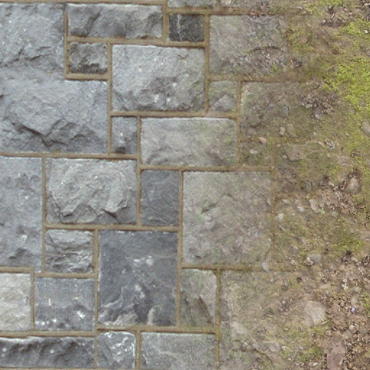
To Do Exercises
1. Recompile and run the program to see the alpha mapped texture combination. Press escape to quit.
2. Make some of your own alpha maps and use them to combine the two textures in different ways.
Source Code
Source Code and Data Files: dx11win10tut19_src.zip
![]()
![]()